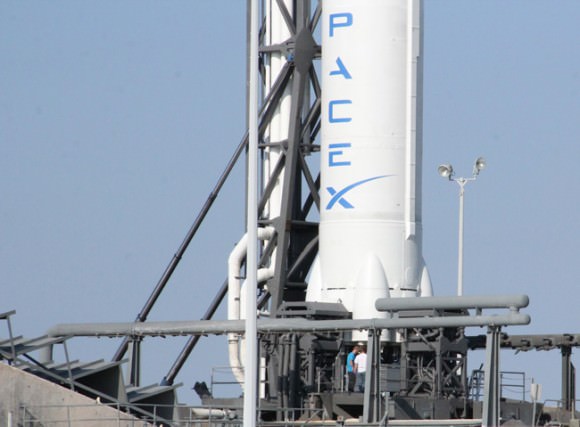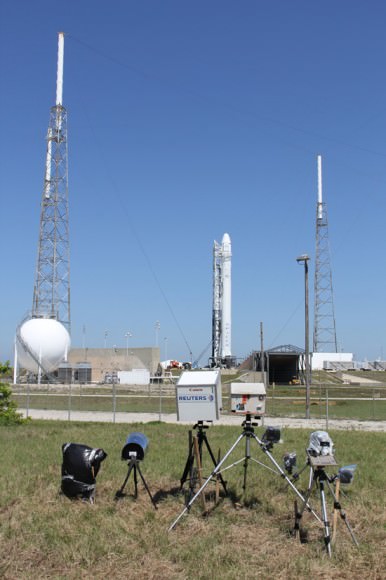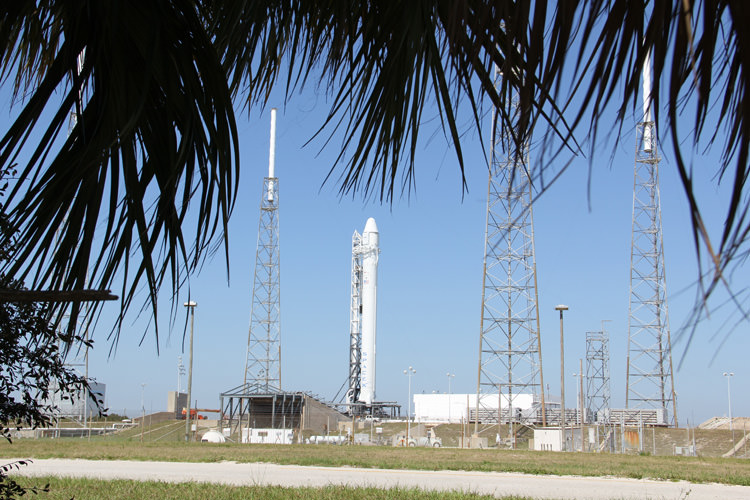[/caption]
SpaceX engineers have successfully replaced a faulty valve in a first stage engine that triggered a launch abort on May 19 and that now clears the way for a second launch attempt of the firms Falcon 9 rocket and Dragon spacecraft in the overnight hours early on Tuesday, May 22.
Litfoff of the Falcon 9/Dragon duo on the first private rocket bound for the International Space Station (ISS) is slated for 3:44 AM on May 22 on the historic test flight mision dubbed COTS 2.
“We are ready for blastoff on May 22,” SpaceX spokeswoman Kirstin Grantham told Universe Today during an interview at Space Launch Complex-40 at Cape Canaveral, Florida earlier today as the Falcon 9 rocket was standing erect at the pad under a brilliant blue sky.
“The work to replace a faulty nitrogen engine valve is complete and took just a few hours,” Grantham confirmed to me.
After a thorough inspection of the vehicle and analysis of the repair, the SpaceX team cleared the rocket for launch. The rocket remained vertical during the repair work.

A team of SpaceX engineers diligently assessed the cause of the May 19 launch abort for the Falcon 9 rocket poised at Pad 40 on Cape Canaveral Air Force Station. Credit: Ken Kremer/www.kenkremer.com
The weather forecast has improved markedly to an 80% chance of favorable conditions at launch time because the chance of rain showers has decreased. The primary concern is for cumulus clouds.
The launch will be broadcast live on NASA TV and via SpaceX Webcast at http://spacex.com
As on May 19, the launch window is instantaneous meaning SpaceX has just a fraction of a second to get the vehicle off the ground and there is no chance to recycle to a later launch time on the same day.
“The next possibility to launch after May 22 is on May 25,” said Grantham in the event of a scrub on Tuesday. “We could not reserve May 23 due to a conflict with Air Force requirements.”
The two stage Falcon 9 rocket is 157 feet tall. The first stage generates a million pounds of thrust from nine Merlin 1 C engines configured in a 3 by 3 by 3 arrangement.
The May 19 launch was aborted in a split second by the flight computer just 0.5 seconds before liftoff when they detected a slightly high pressure in the combustion chamber of engine number 5 located at the center of the first stage core.
If the launch proceeds as planned, the Dragon will separate from the Falcon 9 second stage some nine minutes after liftoff. Over the next two days, Dragon will close in on the ISS and then perform a series of complicated and stringent rendezvous and abort tests that bring the vehicle to within 1.5 miles and prove it can safely dock at the ISS and pull away in an emergency to prevent any chance of crashing into the ISS.
If NASA is satisfied with the test results, Dragon will be grappled with the robotic arm by US Astronaut Don Pettit and berthed at a port on the ISS on May 25. Astronauts would open the hatch on May 26 and begin unloading the nearly 1200 pounds of cargo consisting of non-critical items such as food, water, clothing and science experiments.

This is the first third test flight of the Falcon 9 rocket and the first test flight of the Dragon in this vastly upgraded configuration with solar panels.
Only four entities have ever sent a spacecraft to dock at the ISS – the United States, Russia, Japan and the European Union.
If successful, SpaceX will open a new era in spaceflight by giving birth to the first fully commercial mission to the orbiting space station complex and unlock vast new possibilities for its utilization in science and exploration.
SpaceX is under contract with NASA to conduct twelve Falcon 9/Dragon resupply missions to carry about 44,000 pounds of cargo to the ISS for a cost of some $1.6 Billion over the next few years.
The purpose of Dragon is to carry supplies to the ISS and partially replace the cargo capabilities of NASA’s now retired space shuttle. Dragon is a commercial spacecraft designed and developed by SpaceX that will eventually blast astronauts to space.

